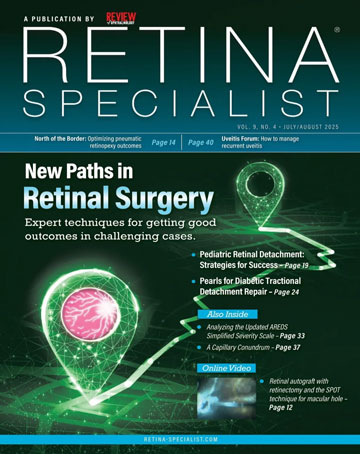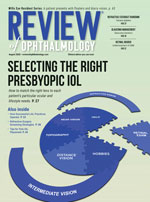A few years ago, I recall one of my fellows telling me about some research into portable optical coherence tomography devices that eventually might be so small and inexpensive that they could even be incorporated into smartphones.
At the time, that sounded like science fiction, but just recently the Food and Drug Administration approved the first patient self-operated home OCT device. While it’s not the size of a smartphone, I suspect we may be on the cusp of a new era in managing patients receiving intravitreal injections.
I had the opportunity to try out the device and found it simple to use. As detailed in this issue’s article by Prithvi Bomdica, MD, and Kevin Blinder, MD, there have been only a few small studies, but they have suggested that the device correlates well with in-office OCT. The artificial intelligence algorithm for quantifying fluid appears to be quite accurate, and it may allow for safe extension of injection intervals.
I’ve also been surprised by the scan quality and web-based viewing platform for monitoring patients. It’s incredible to see how the fluid changes on a day-by-day basis after an injection and then slowly recurs. Ultimately, larger studies, including DRCR Retina Network’s Protocol AO, will be needed to establish the efficacy of home OCT.
If these studies confirm a benefit, there are several unknowns. How much will it cost? What insurances will cover it? How will this impact the flow in our clinic? Imagine clinics that are greatly debulked, leaving mainly patients who definitely need treatment. However, would this create some days that are light and others that are massively overbooked if a bunch of alerts come in simultaneously?
Since the device is only scanning a 3-x-3-mm area, what about issues outside that area? For example, if we eventually use this in diabetic retinopathy patients, we may not detect the development of retinal neovascularization.
Another consideration is societal. Given the cost and need for it to be in a location with internet connectivity, it’s possible that mainly people with resources will be able to obtain the device. Those with less means, who arguably would benefit the most because it could decrease the treatment burden in an already stressed environment, might not be able to and would still be prone to loss to follow-up and worse outcomes.
There will no doubt be a lot of bumps along the road that we will need to figure out. Nevertheless, it’s a step in the right direction that will hopefully lead to better outcomes while decreasing the burden on patients and physicians. RS
 |




